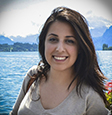
Lala Meredith-Vula: Kosovo’s landscapes seemed to me like paintings
Photographer brings rural Kosovo to global exhibition.
|2017.07.12
|

Lorina Hoxha
Lorina Hoxha is an urban strategist currently based in Tirana. She holds a Master’s degree in Urban Sociology from the University of Amsterdam. Lorina was previously engaged as an editorial intern at K2.0.
This story was originally written in English.